By Neil Earle
Back in November 7, 2001, The Wall Street Journal ran a fascinating report by Clare Ansberry titled “Diverted on Sept. 11, Stranded Fliers Made Enduring Connections.” The subtitle? “Of some 200 Planes Rerouted, Many Got to Newfoundland, Army Cots and Fast Friends.”
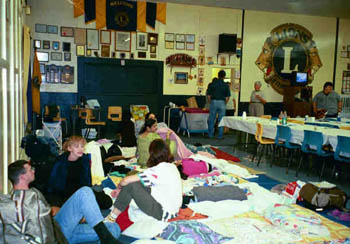
The reference was, of course, to the tens of thousands of international passengers – mostly Americans – forced to land across Canada when the horrific terrorist attacks of September 11, 2001 led to the shutting down of all commercial aircraft in the United States. As the Vancouver Olympics wound down in 2010, NBC’s Tom Brokaw hosted a documentary on how neighborly Canadians came to the aid of stranded US travelers in the grim days after September 11, 2001. Millions of Americans got to see it. Many wept unashamedly as the story unfolded.
Ten years later it might be timely to revisit some of the details of this story, the saga of the “plane people,” as Newfoundland townsfolk dubbed their unexpected guests.
The Journal reported the case of Lynn Nemser, a Pittsburg management consultant, who was assigned to the Camp of the Silver Birches, a Salvation Army retreat on a lake in Newfoundland. Her USAir Jet was forced to land at Stephenville – ironically an abandoned US Air Force base – on that September 11. Stephenville had to welcome 13 flights and about 1200 people, swelling the local population handily.
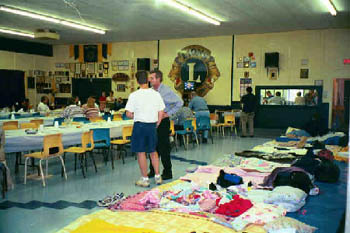
One result? Major Ross Bunjay, the Salvation Army commander at Silver Birches, now receives binders full of mail from Nemser and others of the 256 passengers of Flight 741. According to the Journal, the reception in Stephenville-Corner Brook was nothing short of spectacular: “A store owner donated new sheets valued at $3000. The cable company installed a dish outside the Craft Building, gratis, to supplement the news…[T]he Salvation Army and the RCMP cooked and served scrambled eggs, bacon and toast one morning…”
There was even free entertainment. “The Sharecroppers, a trio of full-time teachers, part –time musicians came by to sing about cod fishing and lumber. A politician gave a speech and handed out pins and maps of Canada, which helped because many of them didn’t know where Newfoundland was.”
In St. John’s, Newfoundland’s capital, passengers from some 30 flights were unloaded to help passengers find refuge in churches, and in Diane Breen’s first-grade classroom, or on army cots at the Lion’s Hall and on pallets inside St. John’s new civic centre.
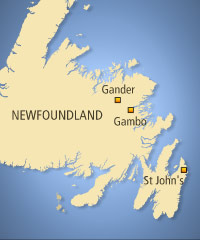
But it was in the little city of Gander, where the biggest crowds had to be fed, assisted, and housed during the crisis. Gander Airport, known as the “crossroads of the world” when many of us were growing up in the 1950s, had the runway space to do the job. It was later enlarged to receive the space shuttle in an emergency. Up in Goose Bay, Labrador – which did receive the space shuttle Enterprise in 1983 – the first seven transatlantic flights were diverted to safety on 9/11. But Air Traffic Controllers well knew Gander as “the lifeboat of the North Atlantic” for jets in trouble. Everyone from Winston Churchill to Fidel Castro to Frank Sinatra had passed through there.
That much is well known to Newfoundlanders. But before the days of jet travel Gander was famous as a prominent staging point for World War II bomber squadrons coming from the United States and Canada. It gets special mention near the end of the 1942 James Cagney movie “Captains of the Clouds.” Now, on 9/11, fact triumphed over fiction. Very early on September 11 Gander’s huge air-strip had already accommodated 38 planes and 6595 passengers – this in a town with a population of 10,000! At nearby Lewisporte, a town of about 4000, Mayor Bill Hooper, soon played host to several hundred passengers who were soon treated to such local delicacies as partridgeberry jam on toast. “Locals donated cribs, diapers and Pokemon backpacks for young children, and after-shave lotion for men, “ the Wall Street Journal reported, “Bus drivers on strike at the time, set down their picket signs to transport passengers. Townspeople organized hikes in the woods and trips to the Bye the Bay museum and to see whales migrate.”
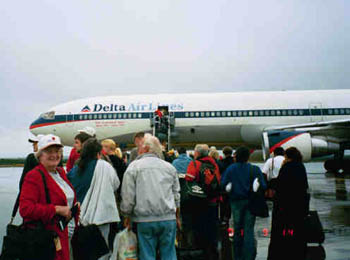
According to an Internet report by a flight attendant from Delta Airlines, the order as well as the open-ended hospitality of the Gander-Lewisporte officials and surrounding towns was impressive and very reassuring to jittery passengers catching their first glimpses of the horror unfolding back in the States. As she wrote:
“We were told that each and every plane was to be offloaded with the foreign carriers given the priority. We were No. 14 in the US category [with] a tentative time to deplane at 6 PM…True to their word, at 6 PM, Gander airport told us that our turn to deplane would come at 11 AM next morning. About 10:30 the next morning…a convoy of buses showed up at the side of the airplane and the passengers were taken to the terminal for ‘processing.’ We found out the total scope of the terror back home only after getting to our hotel and turning on the TV, 24 hours after it all started.
“Meanwhile, we enjoyed ourselves going around town discovering things and enjoying the hospitality. The people were so friendly and they just knew that we were the ‘plane people.’ We got the call 2 days later on the 14th at 7 AM and left for Atlanta at 12:30 PM.”
“But that’s not what I wanted to tell you. What passengers told us was so uplifting and so incredible and the timing couldn’t have been better.”
What did she mean?
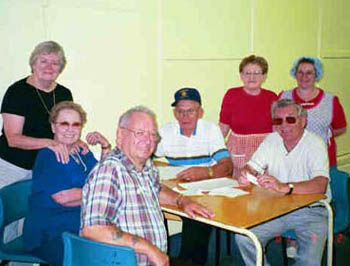
“We found out that Gander and the surrounding small communities within a 75 kilometer radius, had closed all the high schools, meeting halls, lodges and converted all these facilities to a mass lodging area.” According to this Delta attendant, the care and sensitivity exhibited was remarkable: “If any women wanted to be in a women-only facility, that was arranged. Families were kept together. All the elderly were taken to private homes. A young pregnant lady was put up in a private home right across the street from a 24 hour Urgent Care facility. They had both male and female nurses available and stayed with the crowd for the duration. Phone calls and e-mails to US and Europe were available for every one once a day…Local bakeries stayed open to make fresh bread. Food was prepared by local residents. Others were driven to the eatery of their choice. They were given tokens to the local laundromat to wash their clothes.”
Astonishingly, in the words of the Delta crewmember, every single need was met for the passengers of Delta Flight 15. They were delivered to the local airport right on time without anyone missing or late. It gets better: “When passengers came on board it was like they had been on a cruise. Everybody knew everybody else. They were swapping stories of their stay, impressing each other with who had the better time.”
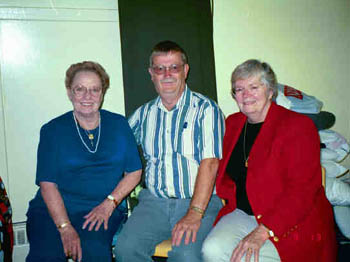
That’s when American generosity came into play. Urged on by Shirley Brooks-Jones, a retired official from Ohio State University now a fundraiser, passengers donated $15,000 while still in the air to set up a scholarship fund for students at Lewisporte. An endowment was set up – in 2002, 14 scholarships were awarded with Brooks-Jones on hand and that year the endowment approached $1,000,000.
Near the first anniversary of 9/11 Miami Herald journalist Jim Defede released his award-winning account, “The Day the World Came to Town,” a fairly comprehensive 244 pages detailing the Gander-Lewisporte story. This may well remain the standard account of the event. Defede skillfully alternated the bitter with the sweet to tell about volunteer SPCA workers crawling on hands and knees in the cargo holds in spite of the muck and the smells to feed and give medical attention to the 21 animals stowed away in the darkened planes. He shows the humor of Werner Baldessarini, ace fashion designer for Hugo Boss fashions, on his way to a big New York event, having to scramble for the last remaining women’s underwear at the local Walmart – underwear being highly prized since passengers could only carry their hand luggage off the planes.
Hundreds of visitors, including Winnie House, an African tribal princess, were “screeched in” at a local Lewisporte pub while townspeople in Gander rallied around to comfort Hannah O’Rourke whose son Kevin, a New York firefighter, was reported missing.
Kevin O’Brien of MediPlus Pharmacy stirred his fellow-druggists to provide 4000 toothbrushes free of charge while thinking of smokers waiting some 30 hours to deplane and two passing out from the lack of nicotine. Nicotine patches were duly sent. Defede gets down all these little things you’d miss on TV – a Jewish rabbi and two fellow-Jews needing kosher meals; O’Brien’s wife manning phones for 42 hours calling 12 different countries to fill prescription medicine orders for passengers unable to retrieve their luggage. Near the end of the 126 hour outreach, Grant Smith of the RCMP had the inspired idea to dress in full Mountie ceremonial to give the passengers something upbeat to remember Canada by. “Your passport and a smile” his band of Sergeant Prestons said to each passenger leaving the security check points.
Little did the principal of Lewisporte Middle School realize that one of her guests working away on his laptop was Gordon Conway, the president of the Rockefeller Foundation. In exchange for such sterling hospitality, Conway and assistant Denise Gray-Felder offered to replace the whole stock of the school’s aging computers. Later the school received $52,500 in special funds for that purpose.
What to make of all this?
Saint Augustine wrote it years ago: Good is more powerful than evil (Proverbs 10:7). Evil, said Saint Augustine, is craven and parasitic and cowardly and can only feed off the good. Both Canadians and Americans showed it once again on 9/11. Good can come out of the most nightmarish tragedies. The Saga of the Plane People reminds us that this is true.
(Carbonear-born Neil Earle is a Los Angeles journalist and broadcaster who returns to Newfoundland each summer.)